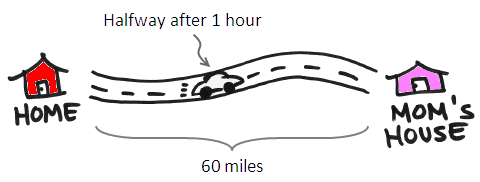Double your productivity without more work or stress

Zappos COO Alfred Lin enlightens us on how to become 37 times more productive in only one year! Can it be?
Let’s hear him out:
Make at least one improvement [every day] that makes Zappos better. It sounds daunting, but remember improvements don’t have to be dramatic. Think about what it means to improve just 1% per day and build upon that every single day. Doing so has a dramatic effect and will make us 37x better, not 365% (3.65x) better at the end of the year. Wake up every day and ask yourself not only what is the 1% improvement I can change to make Zappos better, but also what is the 1% improvement I can change to make myself better personally and professionally—because we, Zappos, can’t grow unless we as individual people grow too.
Imagine yourself making 1% changes every day that compounds and will make you and Zappos 37x better by the end of the year. Imagine if every employee at Zappos was doing the same. Imagine how much better you, Zappos and the world will be next year.
At first glance it’s inspiring. At second glance it’s poppycock. At third glance you wonder how it’s possible for someone to use the word “Zappos” so frequently.
Being 37x more productive is impossible, and I’ll show you why. But along the way it will become clear how becoming 2-3x more productive might be within reach.
His math isn’t the problem per se. It’s true that if you improve 1% each day over the previous day, that’s a 1% compounding rate. My question is: Is it possible to increase your daily productivity by an entire percent every day?
Well, if you can do only 1 pushup, then I believe that you could improve about 1% per day, and end the year being able to do 37 pushups at a time.
But then, it continues. The next year you continue getting 1% better per day, and by the end of the year you can do 1369 pushups in one day. Yeah.
Things rare compound like that, even at slow rates. Or at least, there are other factors that overwhelm that factor.
But, is there a smart way to, say, 2x our productivity? (Once!)
To answer that, I want to give you a fun math puzzle. Yeah, I know, “fun” is relative… Okay look if you don’t like word problems just take a random guess at the answer. If you’re up for the challenge, try to solve it without pen and paper. You know, just to prove your MIT education wasn’t for nothing.
Here’s the puzzle: You get in your car at home and head out towards your mother’s house 60 miles away. (Your mom likes this word problem, I can already tell.) You hit traffic during the first half of the trip, so after 30 miles you’ve averaged only 30 miles per hour.

Now the traffic opens up and you can go as fast as you want. The question is: How fast do you have to go during the second half of the trip such that you’ve averaged 60 mph over the entire trip?
If you’re not using pen and paper, maybe you guessed 90? 120?
Actually it’s impossible! To average 60 mph you need to travel the whole 60 miles in a single hour. But it’s already been an hour! Even if you went 1000 mph during the second half, it would have taken just over an hour to complete the 60 miles, therefore your average is still less than 60 mph.
It’s amazing how periods of low velocity wash away gains of high velocity. In the puzzle, if you doubled your speed in the second half it would increase your trip average from 30 to 40 mph. If you quadrupled your speed in the second half, your trip average would still be only 48 mph.
Once you’re behind, you can’t make up ground no matter how fast you go.
This puzzle illustrates the weird math of velocities, and what applies to “miles” per hour also applies to emails per hour or writing code or writing prose or any other “gettin’ stuff done” per hour.
The problem with improving your productivity is that so much of your day is occupied by low-velocity activity—dealing with emails you didn’t really need to see, dawdling in a meeting that hasn’t started yet, or spending too much time reading blogs. (Present company excepted.)
When half your day moves at 30 mph, it’s impossible to make up the time during the other half.
This is the problem with Lin’s 1% idea—the low-velocity stuff makes it too difficult to improve even 1% overall, at least not every day of the year. Even with 37x improvement in some areas, you still might not be 2x more productive overall.
There’s good news here, however! Once you realize that the low-velocity stuff is responsible for most of the drag on your productivity, you realize that the thing to do is eliminate the low-velocity stuff. Yes it’s good to learn to type faster, but cutting down on the time it takes to process useless email might help even more.
Ready for more good news? There are free tools that help you identify what the low-velocity stuff is. I use one called RescueTime. To show you how useful this is, consider this example of my stats for one week:

Whoa—almost eight hours of email. That’s a solid, uninterrupted, full day of nothing but email I’m blowing through every week. Is that really the way I should be spending the majority of my time?
Even the long tail can be instructive. Notice the 45 minutes of “Calendars.” A drill-down bears out the awful conclusion—yes I spent almost an hour in Google Calendar. It’s true this week was completely packed with events, but still.
Another realization: I had an averaged 5.5 hours of activity per day. I was in the office for over 8 hours every one of those days—the rest is sopped up with meetings, office chatter, and lunch. Here’s the mythical eight-hour workday quantified—I’m starting with 5-6 and even then I spent much of it fielding email.
Once you see the numbers it’s easy to correct. I now notice more when I’m in an office conversation that’s past the point of being productive. There’s millions of tips for how to process email more efficiently.
So if you’re serious about wanting to increase productivity by, say, 2x, you can. Identify the biggest perpetrators of low-velocity activity and eliminate them, then do a little surgery on your high-value tasks.
The best part is, none of this means working late or working harder. Just stop averaging down!
https://longform.asmartbear.com/double-your-productivity/
© 2007-2024 Jason Cohen
 @asmartbear
@asmartbear




